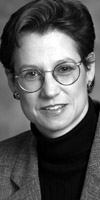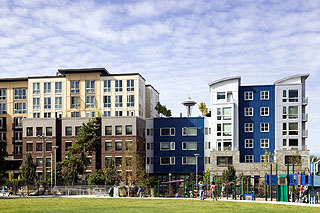
DJC.COM
March 30, 2006
Toward a sustainable future in South Lake Union
Vulcan

Healey
|
But if Seattle is to retain its springtime splendor for future generations, green development must be held up as a year-round model of the way we build, embrace and care for our city and environment.
In the simplest terms, green development is a broad yet practical design orientation that seeks to enhance human health, community and economic resilience as our city grows. With economic forecasts suggesting that Western Washington's population will grow by 100,000 annually for at least the next 10 years, it becomes more important than ever to adopt sustainable development practices to ensure our region's long-term vitality.
While it begins in our homes — where already we are making greater strides in reducing, reusing and recycling materials — green development filters out into many aspects of our world, from creating healthier workplaces to reducing our dependency on the automobile.
Look around Seattle today and you can already see real-world evidence that "going green" is catching on.

Photo by Steve Keating
Residents at the 162-unit Alcyone live across from the newly renovated Cascade Park and Playground. Other urban amenities include a rooftop P-patch, a ground-floor pub and access to the planned South Lake Union streetcar line.
|
New developments are incorporating sustainable design and materials from the ground up. More green space is being made available via public parks. And developers are supporting greater density downtown, creating clusters of urban communities where infrastructure already exists and mixed-use complexes are encouraging a car-free lifestyle.
Still, there's more to the process than watching LEED buildings get erected. It takes all of us individually to become educated on green practices and help spread the adoption of green initiatives on a wider scale. This awareness is now starting to take root at the neighborhood level in Seattle, where sustainable concepts are being embraced on all fronts.
Alley24
In South Lake Union's Cascade neighborhood, for example, workers and residents are benefiting from the design and construction of infrastructure, buildings, landscapes and energy systems.
The neighborhood is grounded in many forms of sustainability — everything from public green space, pedestrian-friendly streetscapes, alternative forms of transportation and buildings — designed with energy efficiency and conservation in mind to provide a healthier work/live experience.
Located in the neighborhood across the street from REI is Alley24, a new 362,000-square-foot mixed-use project developed by Vulcan that recently opened its commercial portion to nearly 1,000 employees from NBBJ, Skanska and WPP.
The development embodies South Lake Union's sustainable spirit in ways that also complement the character of the existing neighborhood while offering a mix of office, residential and retail uses that encourage a more livable, walkable community.
Hybrid HVAC
Alley24 is one of Seattle's first mixed-use projects expected to achieve LEED certification.
One of its unique features is its hybrid HVAC system, offering tenants a choice of natural ventilation, energy-efficient air conditioning or both.
The flexibility to control personal climate not only improves employee comfort and productivity, but also is expected to reduce energy costs by as much as 15 percent to 20 percent.
The use of air conditioning — traditionally the biggest consumer of energy in an office building — will be unnecessary for most of the year because of access to fresh air through operable windows. When air conditioning is required, an innovative underfloor HVAC system provides the most energy-efficient delivery by distributing air at floor level where occupants reside.
Other conservation measures include daylighting, low-energy and water-saving fixtures, and exterior sunshades and reflector blinds to moderate the building's temperature.
The Alley24 design also includes green space with a 700-square-foot rooftop deck, which includes a landscaped garden and pleasant views.
Cascade Park
More expansive open space can be found at the recently renovated Cascade Park, located across the street from Alley24.
Showcasing the results of a partnership between the city, community and local property owners, including Vulcan, Pemco and Harbor Properties, the renovated Cascade Park and Playground provides a more inviting gathering place for residents, children and families and has also helped renew the community's shared identity.
The 1.9-acre park features an innovative display of stormwater runoff, native landscaping, an outdoor plaza and several sustainable elements built into the design of the park. Even small wildlife benefit from the park's vegetative cover and food supply.
Alternative transportation is also being encouraged throughout the neighborhood. A streetcar will soon begin operating a few blocks away along Westlake and Terry avenues, connecting workers and residents to the rest of the city as well as regional transportation systems.
In the meantime, a Flexcar car-sharing program, charging stations for electric vehicles and bicycle storage facilities available for residents at Alcyone Apartments are already helping to limit automobile use and cut fuel consumption in the neighborhood. Alley24 tenants and residents will also soon be able to enjoy the added conveniences of these alternative transportation options.
Alcyone
Developed by Vulcan and Harbor Properties, the 162-unit Alcyone project opened its doors in 2004 and represents another model of sustainability in the Cascade neighborhood as Seattle's first LEED-certified, market-rate multifamily project.
Built on an urban infill site, Alcyone was constructed with a high percentage of recycled materials as well as with nontoxic paint and flooring. Ninety-five percent of its construction waste was recycled.
In addition to enjoying the benefits of pollution controls, indoor-air quality and energy-saving measures, Alcyone residents are incorporating green practices into their everyday lives. Examples include individual organic gardens that residents maintain in an 800-square-foot rooftop P-patch irrigated with recycled rainwater. Paddy Coyne's Irish Pub on the ground floor also provides an inviting social locale for Alcyone residents and neighbors.
Seattle has been at the forefront in creating an environment devoted to sustainable development, but the next several decades are critical in creating the model that future generations may follow. We are already seeing a glimpse of how green communities can flourish in South Lake Union's Cascade neighborhood, and we need to support these approaches on a broader scale if we are to ensure our region's quality of life is preserved for years to come.
Ada M. Healey is the vice president of real estate at Vulcan. Vulcan Real Estate manages a diverse development portfolio that includes nearly 60 acres in Seattle's South Lake Union neighborhood.
Other Stories:
- Tips for designing an energy-efficient building
- Historic preservation projects can be green
- Low-impact development gets a test in Renton
- Smart lighting design: go for timeless, not trendy
- Brownfield project demonstrates Seattle's creative know-how
- 3 advances show the future of site development
- What does a sustainable school cost?
Copyright ©2009 Seattle Daily Journal and DJC.COM.
Comments? Questions? Contact us.